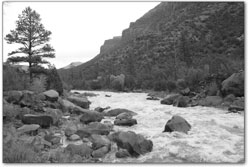| ||||
Dolores River releases evaporate
by Ken Wright It looks like the River of Sorrows is going to live up to its name this year – for the boating community, anyway. The Bureau of Reclamation updated its forecast for the river on Tuesday, and there will be no boatable flows for the entire season. It’s been an up-and-down year for those anticipating time on the Dolores River. In November, the Bureau predicted that, following last year’s relatively wet winter, a snowpack of only 55 percent of average would allow McPhee Reservoir to spill water for boating. The early winter, though, didn’t come through, and the outlook looked bad. Then late-winter snows again raised hopes. On the forecast posted on the Dolores Water Conservancy District’s website on April 18, it appeared flows would hit near 800 on May 25, and rise to more than 1,000 cfs on May 26, lasting through June 9. Over the course of the last month, though, the snowpack again dropped from 89 percent of normal to a meager 20 percent to start May, explained Vern Harrell, of the Bureau of Reclamation. In early April, runoff was forecast at 210,000 acre-feet (the average is 320,000), but after a dry, warm, windy April, that figure has been scaled down to 180,000. “I’m not thinking we’re going to have any boatable flows now,” said Harrell. “Pretty much what happened was April. We got an early run off and warm winds that evaporated the rest.” Lots of people are going to be disappointed. “There have been a lot of people calling from all over the country,” Harrell said. “I feel sorry for them. I was even going to get a boat myself this year. Let’s hope for some water next year.” Next year, actually, is looking critical, Harrell explained. “There will be enough water for irrigation this year. The reservoir is close to full because of the carryover from last year. Last year saved us from the drought of previous years. But if we don’t get some snow next year, we’ll all be in a lot of trouble.” BLM River Ranger Rick Ryan isn’t surprised by the announcement. “That’s what I’ve figured from the beginning,” he says. Instead of spending days on river, Ryan said he’ll be working on other projects and spending time on the ground in Canyons of the Ancients National Monument. Ryan points out, though, that a lack of boating doesn’t have to keep people out of the Dolores River country: The riverside campgrounds at Bradfield Bridge and down by the Dove Creek pumphouse will remain open. The bleak boating forecast also isn’t going to stop studies from being performed by the Dolores River Dialogue. Begun in 2004, the Dialogue brings together various stakeholders in the river to work together to find added flows for fish habitat and commercial and private recreation, while maintaining the regional economies dependent upon the Dolores Project’s water. Among the group’s projects, the Dialogue is working on gathering science that will help improve spill management from McPhee Reservoir. The 2005 season provided a golden opportunity for the Dialogue to move forward: Not only did it serve up the first boatable flows in five years, it also saw the largest flows on the river since McPhee first plugged the stream, with peak flow hitting 4,200 cfs.
Following last year’s peak runoff, the Dialogue, working with federal, regional and tribal management agencies, as well as with the Dolores River Coalition, which represents more than 20 groups with vested interests in the river, launched a scientific study of the rare high water. Scientists were able to fly the entire length of the stream below the dam and film of the effects of the spill. “The goal of the Dialogue is to study the way the river responds to the variety of flow conditions,” explained Mike Preston, of the Office of Community Services at Fort Lewis College and facilitator of the Dolores River Dialogue. “Last year, we got to see how the river responded to a flushing flow.” The hope this year was for the Colorado Division of Wildlife to do a fish survey in Slickrock Canyon, which hasn’t been done since 1993. But that survey must be done by boat. Even if that project can’t be tackled, the Dialogue will continue setting up an 11-mile stretch around Big Gypsum Valley as a river-study baseline area. Among other things, the group wants to see if removing tamarisk improves the way the river responds to flushing flows. “Tamarisk has been encroaching on the channel. It propagates in low-water years, and makes the channel cut deeper,” says Preston. Then, when the river floods, “the river has a hard time finding its old channel.” This is problematic for healthy riparian vegetation such as cottonwoods, which do better when the river spreads out during big flows. To achieve this, it’s important to go in and do survey work to establish a good baseline so you can measure variations off that baseline, Preston said. “Whatever the flow conditions are, we’re going to have Fort Lewis College graduates doing those surveys.” For everyone else wanting to get on the river for more selfish reasons, it’s still too early for absolute despair: The Bureau’s latest projections are, of course, just forecasts – and on the Dolores, forecasts can be off as much as 10 percent, says Harrell. Plus, it could still rain or snow. Harrell urges people to keep checking updated predictions at www.doloreswater.com. Forecasts are updated every two weeks, and once a week starting in mid-May. Until then, “pull out the mountain bike,” urges Harrell. “That’s what I’m going to do.” •
|



